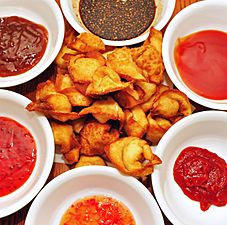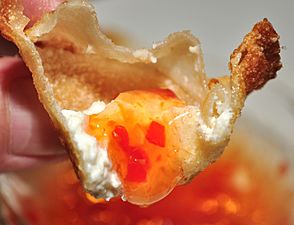Crab Rangoon facts for kids
 |
|
| Type | Dumpling |
|---|---|
| Course | Appetizer |
| Place of origin | United States |
| Main ingredients | Wonton, cream cheese, crab meat or imitation crab meat, scallions, garlic |
| Crab Rangoon | |||||||||||
|---|---|---|---|---|---|---|---|---|---|---|---|
| Chinese | 蟹角 | ||||||||||
| Hanyu Pinyin | xiè jiǎo | ||||||||||
| Cantonese Yale | háaih gok | ||||||||||
| Literal meaning | Crab horn | ||||||||||
|
|||||||||||
| Alternative Chinese name | |||||||||||
| Traditional Chinese | 炸蟹角 | ||||||||||
| Hanyu Pinyin | zhǎ xiè jiǎo | ||||||||||
| Cantonese Yale | ja háaih gok | ||||||||||
| Literal meaning | Fried crab horn | ||||||||||
|
|||||||||||
| Second alternative Chinese name | |||||||||||
| Traditional Chinese | 蟹仰光 | ||||||||||
| Hanyu Pinyin | xiè yǎng guāng | ||||||||||
| Cantonese Yale | háaih yéuhng gwōng | ||||||||||
| Literal meaning | Crab Rangoon | ||||||||||
|
|||||||||||
Crab Rangoon, sometimes called crab puffs or cheese wontons, are crispy, filled dumplings. They are a popular appetizer served mainly in American Chinese restaurants.
Contents
How Crab Rangoons Are Made
Crab Rangoons have a tasty filling inside a crispy wrapper.
What's Inside?
The filling is usually made from a mix of cream cheese, crab meat (or fake crab meat), scallions (green onions), and garlic. Sometimes other flavors are added too.
Wrapping and Shaping
A small amount of this filling is placed into a thin Chinese wonton wrapper. The wrapper is then folded into different fun shapes. It can be a triangle, a four-pointed star, or even gathered up like a flower or a small purse. Some are twisted into the classic wonton shape.
Cooking and Serving
After shaping, the appetizers are cooked until they are golden and crispy. They can be deep-fried in oil or baked in an oven. Crab Rangoons can be served hot or cold. In North America, people often eat them with a dipping sauce. Popular sauces include soy sauce, plum sauce, duck sauce, sweet and sour sauce, or hot Chinese mustard.
Where Do Crab Rangoons Come From?
The exact history of Crab Rangoon is a bit of a mystery.
American Invention?
Crab Rangoon was on the menu at a famous "Polynesian-style" restaurant called Trader Vic's in San Francisco. This was back in 1956. Even though some people thought it came from a Burmese recipe, it was probably created in the United States. Victor Bergeron, who started Trader Vic's, is often given credit for inventing it.
Why It's Likely American
It's unlikely that Crab Rangoon came from Southeast Asian or Chinese cooking. This is because cream cheese and other types of cheese are not common ingredients in those traditional cuisines.
Other Names for Crab Rangoons
You might hear Crab Rangoons called by a few different names.
Common Nicknames
They are sometimes known as crab pillows, crab cheese wontons, or just cheese wontons.
Crab Puffs
In the Pacific Northwest states of the US, they are also called crab puffs. However, "crab puffs" usually means a similar dish made with puff pastry instead of a wonton wrapper.
Gallery
See also
 In Spanish: Rangoon de cangrejo para niños
In Spanish: Rangoon de cangrejo para niños




